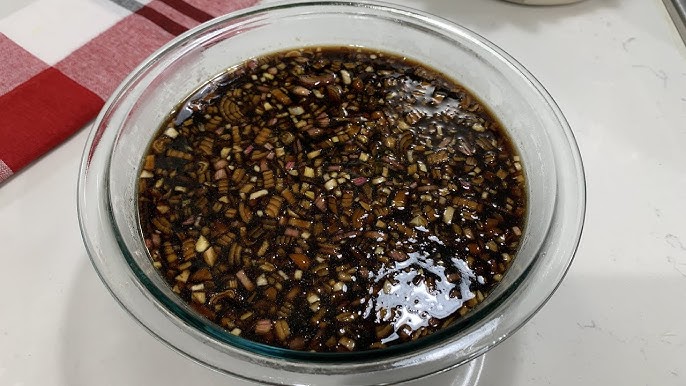Chinese Brown Sauce Recipe: Chinese brown sauce is one of those magical components that can instantly transform a simple dish into something irresistible. If you’ve ever ordered beef and broccoli, chicken stir-fry, or lo mein from your favorite Chinese restaurant, you’ve likely tasted this savory, slightly sweet, and deeply flavorful sauce. What makes it special is its unique balance—salty soy sauce, earthy oyster sauce, aromatic garlic and ginger, and just the right amount of sweetness to round it all out.
Unlike pre-made bottled sauces, homemade Chinese brown sauce allows you to control the depth of flavor, the thickness, and even the sodium level. It’s versatile enough to be used in stir-fries, as a dipping sauce, or even as a marinade for meats and vegetables.
From a cultural standpoint, brown sauce represents a staple in Chinese-American cuisine. While authentic Chinese cooking varies widely depending on the region, this sauce has become a signature in Westernized Chinese restaurants, especially in dishes popularized in the U.S. Its deep umami flavor makes it universally appealing, which explains why it’s a favorite across homes and restaurants alike.
By the end of this guide, you’ll not only know how to make authentic Chinese brown sauce at home, but you’ll also be equipped with the tricks to adjust it to your liking—whether you prefer it more garlicky, spicier, or thicker. Think of this as your go-to master recipe that you can tweak and reinvent based on your personal taste.
Ingredients You’ll Need for Chinese Brown Sauce
When making Chinese brown sauce, it’s best to gather everything in advance. A proper mise en place ensures that once you start cooking, everything flows smoothly. Below is a detailed list of the key ingredients you’ll need.
Essential Pantry Staples
- Soy Sauce: The backbone of the sauce, giving it that salty, umami base. Light soy sauce works best, but dark soy can be added for richer color.
- Oyster Sauce: Adds depth and a slightly sweet, oceanic flavor. This is a must for authenticity, though alternatives exist.
- Cornstarch: Acts as the thickening agent, giving the sauce its velvety consistency.
- Brown Sugar (or White Sugar): A touch of sweetness balances the saltiness.
Fresh Ingredients for Extra Flavor
- Garlic: Freshly minced garlic enhances aroma and sharpness.
- Ginger: Provides warmth and a subtle spiciness that brightens the sauce.
- Green Onions: Optional, but they add a mild onion-like freshness.
Substitutions and Alternatives
- Vegetarian Oyster Sauce (made from mushrooms) for a vegan-friendly option.
- Tamari or Coconut Aminos instead of soy sauce for gluten-free diets.
- Chicken Broth, Beef Broth, or Vegetable Broth as the liquid base—each choice changes the flavor profile.
Having these ingredients ready makes the process seamless, and the beauty is that most of them are pantry staples. Once you master the combination, you’ll be able to whip up this sauce in less than 10 minutes anytime you need it.
Step-by-Step Guide to Making Chinese Brown Sauce
Now, let’s dive into the actual cooking process. Making Chinese brown sauce is quick, but each step matters if you want to achieve that restaurant-quality flavor and texture.
Step 1 – Preparing the Base
Start with the broth of your choice—chicken broth if you’re making chicken stir-fry, beef broth for beef dishes, or vegetable broth if you’re keeping it vegetarian. This liquid forms the base of the sauce.
In a small mixing bowl, combine soy sauce, oyster sauce, and a teaspoon of sugar. This mixture should taste balanced—not too salty, not too sweet. Think of it as the foundation of your flavor profile.
Step 2 – Mixing the Aromatics
Heat a small amount of oil in a pan or wok over medium heat. Add freshly minced garlic and ginger. Stir-fry for about 30 seconds until fragrant. Be careful not to burn them—burnt garlic will overpower and ruin the sauce.
These aromatics infuse the oil with flavor, which will then blend into the sauce and enhance its complexity.
Step 3 – Adding the Broth and Seasonings
Pour in the broth-soy-oyster mixture and stir well. Bring it to a gentle simmer. This step allows all the flavors to meld together, creating that signature savory base.
At this point, you can taste and adjust. Need more saltiness? Add soy sauce. Want more sweetness? Sprinkle in a bit more sugar.
Step 4 – Thickening the Sauce
Mix cornstarch with cold water to create a slurry. Slowly drizzle this mixture into the simmering sauce while stirring constantly. Within seconds, the sauce will start to thicken and turn glossy.
The trick here is not to over-thicken. The sauce should coat a spoon nicely but still pour easily.
Step 5 – Taste Testing and Adjustments
Turn off the heat and give it a final taste. Adjust if needed—maybe a dash of sesame oil for nuttiness or a pinch of chili flakes for heat. This last step is your chance to customize the sauce to your liking.
At this point, you’ve got a restaurant-quality Chinese brown sauce ready to elevate any dish you pair it with.
Tips for Perfect Chinese Brown Sauce
Perfecting Chinese brown sauce goes beyond just following the recipe. Small tweaks and adjustments can make the difference between an average sauce and one that tastes like it came straight out of a professional kitchen.
Balancing Sweetness, Saltiness, and Umami
The holy trinity of Chinese brown sauce lies in achieving balance. Too much soy sauce can make it overly salty, while too much sugar can turn it into something resembling teriyaki sauce. Always aim for harmony among salty, sweet, and savory (umami) notes.
Common Mistakes to Avoid
- Burning the garlic: This will make the sauce bitter.
- Adding cornstarch directly: Always mix it with water first, or it will clump.
- Over-thickening: A sauce that’s too thick will feel heavy instead of silky.
How to Customize the Flavor
- Add chili paste for a spicy kick.
- Stir in a teaspoon of hoisin sauce for more sweetness and complexity.
- Use Shaoxing wine (Chinese cooking wine) to add depth and a subtle tang.
The beauty of Chinese brown sauce lies in its flexibility. With a few adjustments, you can make it your own and adapt it to any dish.
Serving Ideas for Chinese Brown Sauce
Chinese brown sauce isn’t just a sidekick—it’s the star that ties everything together. The beauty of this sauce lies in its versatility. Once you have a jar ready, you can use it in countless ways to bring your meals to life. Let’s look at some of the best ways to enjoy it.
Best Dishes to Pair With Brown Sauce
The most popular pairing is, of course, stir-fried beef and broccoli. The tender beef soaks up the savory sauce, while the broccoli adds a crunchy balance. But that’s just the beginning. Chicken with mixed vegetables, shrimp with snow peas, and tofu with bok choy all become restaurant-quality dishes with a splash of brown sauce.
It also works beautifully as a finishing sauce for lo mein and chow mein. The glossy texture clings to noodles, ensuring every bite is packed with flavor. Even plain steamed rice tastes gourmet when drizzled with brown sauce.
How to Use It as a Stir-Fry Base
Think of brown sauce as your stir-fry canvas. Start by cooking your protein—chicken, beef, shrimp, or tofu—then toss in vegetables like bell peppers, mushrooms, or snap peas. Once everything is nearly cooked, pour in the brown sauce and stir until everything is evenly coated. The sauce thickens as it hits the hot wok, locking in the flavors.
Creative Ways to Incorporate It in Meals
- As a dipping sauce: Perfect for dumplings, egg rolls, or potstickers.
- As a marinade: Coat meats in brown sauce before grilling or baking to infuse flavor.
- As a glaze: Brush it over roasted vegetables or even salmon for a sweet-savory finish.
When you realize how versatile it is, you’ll want to keep a batch in your fridge at all times.
Storage and Make-Ahead Options
One of the best things about Chinese brown sauce is how well it stores. It’s a lifesaver on busy days because you can make it ahead of time and simply reheat when needed.
Refrigerating and Freezing the Sauce
After cooking, let the sauce cool completely. Store it in an airtight container or glass jar and refrigerate. It keeps well for up to one week.
For longer storage, freeze the sauce in small portions using an ice cube tray. Once frozen, transfer the cubes to a zip-lock bag. This way, you can thaw just the right amount when you need it. Frozen brown sauce lasts up to 3 months without losing much of its flavor.
Reheating Without Losing Flavor
The best way to reheat brown sauce is on the stovetop over low heat. Add a splash of water or broth to loosen it up, as it tends to thicken when stored. Avoid microwaving directly, as uneven heating can cause it to separate.
Making it ahead means you’re always one step closer to a delicious, home-cooked Chinese meal—even on the busiest nights.
Variations of Chinese Brown Sauce
While the classic version is unbeatable, sometimes it’s fun to switch things up. Depending on your taste or dietary preferences, you can easily adapt this sauce.
Spicy Brown Sauce Version
For those who love heat, add chili paste, sriracha, or dried red chili flakes while cooking. This gives the sauce a fiery kick, perfect for dishes like kung pao chicken or spicy beef stir-fry.
Vegetarian and Vegan Options
Traditional brown sauce uses oyster sauce, but you can swap it with mushroom-based vegetarian oyster sauce or hoisin sauce. Vegetable broth works as the liquid base, making it fully plant-based without losing depth of flavor.
Restaurant-Style Thick and Glossy Sauce
Ever wonder why restaurant sauces look extra shiny? The secret is in the cornstarch ratio and sometimes a drizzle of sesame oil. Using slightly more cornstarch creates that glossy, clingy finish you find in takeout dishes.
With these variations, you can tailor the sauce to fit any craving or occasion.
Nutritional Value of Chinese Brown Sauce
Homemade Chinese brown sauce is not only tastier but often healthier than store-bought or takeout versions. Knowing what goes into it helps you make smarter choices.
Calories and Macronutrient Breakdown
On average, two tablespoons of brown sauce have:
- Calories: 35–50
- Protein: 1g
- Fat: 0–1g
- Carbohydrates: 7–10g
- Sodium: 500–700mg (depending on the soy sauce used)
The sodium level is usually the main concern. Using low-sodium soy sauce makes a big difference without sacrificing too much flavor.
Healthier Ingredient Alternatives
- Replace sugar with honey or maple syrup for a natural sweetener.
- Use coconut aminos instead of soy sauce for a gluten-free and lower-sodium option.
- Swap cornstarch with arrowroot powder if you’re avoiding corn-based products.
By adjusting these ingredients, you can make a lighter, healthier version that still tastes authentic.
FAQs about Chinese Brown Sauce Recipe
Can I make it without oyster sauce?
Yes! Replace it with mushroom stir-fry sauce or hoisin sauce. The flavor will be slightly different but still delicious.
How do restaurants make it so glossy?
They use the right balance of cornstarch slurry and sometimes add a drizzle of sesame oil for shine. Cooking it quickly at high heat also helps.
What’s the difference between brown sauce and stir-fry sauce?
Brown sauce is a type of stir-fry sauce but more specific. It’s thicker, richer, and usually includes oyster sauce, while generic stir-fry sauces vary widely in ingredients.
How long can it be stored?
Refrigerated, it lasts 5–7 days. In the freezer, up to 3 months.
Can I use it with non-Chinese dishes?
Absolutely! It makes a great glaze for grilled meats, roasted vegetables, and even noodles from other cuisines.
Conclusion
Chinese brown sauce is the secret weapon behind many restaurant-style dishes. With just a few pantry staples and some fresh aromatics, you can create a sauce that elevates any stir-fry, noodle dish, or rice bowl. The best part? It’s quick, customizable, and easy to store for later use.
Once you try making it at home, you’ll never go back to bottled sauces or bland takeout versions. Whether you keep it classic, spice it up, or go vegan, this versatile sauce is guaranteed to become a staple in your kitchen.



